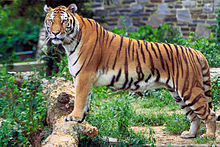Wikijunior:Big Cats/Tiger

Their speed and agility give the tiger the title of "Top Predator," over the larger but slower grizzly bear. The tiger is the largest and most powerful cat species living today. A well rounded athlete, the tiger can climb (though not well), swim, leap great distances and pull with five times the force of a strong human. The tiger is in the same group (Genus Panthera) as lions, leopards, and jaguars. These four cats are the only ones who can roar. The tiger's roar is not like the full-voiced roar of a lion, but more like a sentence of snarly, shouted words.
Where do tigers live?
editTigers live in forests and grasslands of eastern and southeastern Asia. They live in countries such as Bangladesh, Bhutan, China, India, Nepal, Cambodia, Laos, Malaysia, Myanmar, Thailand and Vietnam, Indonesia (Sumatra), and the Russian Far East. The Bengal Tiger is the national animal of Bangladesh and India. They also live in West Bengal, India.
What do tigers look like?
editLike the other big cats, tigers are built much like the much smaller domestic cats that people often have as pets; they are just much bigger and more powerful.
Tigers are usually orange or reddish orange with very bold, uneven black stripes and white areas on the chest, neck, belly and inside of the legs. Their stripes act as camouflage, making it difficult for them to be seen when they are among the trees and shrubs of the jungle. The stripes will vary with each individual tiger.
A tiger usually is about 6 ft to 9 ft in length from nose to tail tip. A large tiger might be 10 ft (3 meters) long. The tail is about 36 inches (91 cm or 3 ft). Tigers weigh about 350 to 550 pounds (160 to 250 kg).
Tigers have very strong teeth and jaws. Their paws are soft and heavily padded, sheathing large, very sharp claws. They also have short, thick, and soft fur and thick long whiskers.
White tigers are those who are born with a certain genetic defect causing loss of pigment in their skin, eyes and fur. These tigers can be white with black, grey, very dark blue, or no stripes; they are not albino.
This loss of pigment is unfortunate for tigers in the wild because their camouflage becomes inadequate. However, this trait may be even more unfortunate for tigers held in captivity. White tigers held in captivity are often forced to breed with their mothers, fathers, siblings, etc. This is usually done to assure that another white tiger cub will be born due to the fact that they are rare and draw in large crowds to zoos, circuses and magic shows. Because these unusually colored tigers are so beautiful and rare, the majority of the public is oblivious to the horrible effects that inbreeding causes in tiger cubs.
These effects may include: an elevated incidence of recessive genetic diseases; reduced fertility both in litter size and in sperm viability; increased congenital defects such as cryptorchidism, heart defects, cleft palates, fluctuating asymmetry (such as crooked faces, or uneven eye placement and size); lower birthweight; loss of immune system function; slower growth rate, smaller adult size; mental retardation, and an increased risk of infant mortality.
What do tigers eat, and how do they catch their prey?
editTigers mostly feed on plant-eaters, or herbivores, like elk, deer, wild pigs, and buffalo. Like the majority of cats, they are solitary hunters, meaning they hunt alone. When a tiger has spotted its prey, it may seek out a good location where it can hide, staying close to the ground, and wait for the perfect moment to pounce and ambush its prey. But when prey becomes scarce tigers also hunt peacocks and rabbits. Resourceful as they are, they also catch and eat fish, as tigers are good swimmers.
People who traditionally live in areas where tigers hunt have learned to avoid tiger attacks by wearing a face-mask on the backs of their heads. Tigers prefer to approach other animals from behind and think twice about pouncing when they can see a face. Fortunately, they rarely attack humans unless they are too ill to hunt their normal prey. [1]. Tigers that attack humans are called man-eaters. Jim Corbett was a famous hunter and conservationist who killed many man-eating tigers in India.
Fun facts
edit- Tigers are striped through and through. If you were to shave a tiger, and few ever have, you would see the stripes on the skin.
- Tigers are superb swimmers, unlike most other cats. They have been known to board fishing boats from the waters in which they swim. Usually they swim because they want to cool off.
- No two tigers have exactly the same pattern of stripes.
- The Siberian tiger is the world's largest naturally occurring cat.
- A tiger was once measured to be 13 feet long.
- Although the tiger is best known for killing with its jaws and teeth, a tiger is strong enough (like bears) to kill animals as large as cattle with a swipe of its paw.
- A tiger named Shere Khan is the arch-villain of Rudyard Kipling's The Jungle Book as the nemesis of the "man-cub" Mowgli.
- A Bengal tiger named "Richard Parker" is a key character in the novel (and highly-successful movie) "The Life of Pi" who must share a boat with a young man cast adrift at sea after the sinking of a ship during a hurricane.
- Tigers are orange because it helps them to camouflague in the grass to catch their prey because their prey are colourblind.
For more information
edit- Tijgeritorium Everything you want to know about tigers!!!
- Wikipedia: Tiger
- Save the Tiger Fund